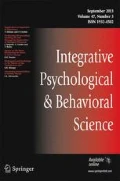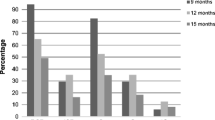Abstract
Adults mediate the relationship between material reality and children, according to functional units of cultural relevance. This paper explores early development of semiotic systems in infants, analyzing rhythmic, sonorous and melodic components, which enable adult-child interaction with and about objects. The triads (with sonorous and non-sonorous objects) was studied longitudinally at age 2, 4 and 6 months. We propose that rhythmic, sonorous and melodic components conformed one of the basic semiotic systems upon the adult's action relies (through gestures and uses of objects) in order to segment and organize objects in the world. Likewise, children actively respond to these presentations and seek sounds for themselves when they are able to interact with the object more autonomously.




Similar content being viewed by others
Notes
The same object was used in a case study of self-regulation function in private gestures on a 18 months old girl with Down Syndrome (Rodríguez and Palacios 2007).
Glissandos are cascades of sounds produced by the adult in an ascending or descending manner.
Ostensive gestures, as happens between adults, were eliminated from this classification because they are produced in a static manner and, therefore, they do not involve either rhythm, nor sound.
Only the sequences of action with the sonorous rings were noted because the adult preferably used them.
References
Andrén, M. (2010). Children’s gestures from 18 to 30 months. Travaux de l’Institut de Linguistique de Lund 50. Lund: Lund University.
Basilio, M., & Rodríguez, C. (2011). Usos, gestos y vocalizaciones privadas. De la interacción social a la autorregulación [Uses, gestures and private vocalizations: from social interaction to self-regulation]. Infancia y Aprendizaje, 34(2), 181–194.
Bates, E., Camaioni, L., & Volterra, V. (1975). The acquisition of performatives prior to speech. Merrill-Palmer Quarterly, 21(3), 205–226.
Bronckart, J. P. (2012). Contributions of piagetian constructivism to social interactionism. In E. Martí & C. Rodríguez (Eds.), After Piaget (pp. 43–58). New Jersey: Transaction Publishers.
Bühler, K. (2009). Théorie du langage [Theory of Language]. Marsella: Agone.
Cárdenas, K., Rodríguez, C., & Palacios, P. (2014). First symbols in a girl with down syndrome: a longitudinal study from 12 to 18 months-olds. Infant, Behavior and Development, 37(3), 416–427.
Cavalcante, S., & Rodríguez, C. (2015). La comprensión del dado como objeto con funciones numéricas. Un estudio longitudinal con dos niños desde los 24 a los 36 meses en interacción con un adulto. Monográfico: Instrumentos semióticos en el conocimiento matemático temprano. [The understanding of dice as an object that has numerical functions. A longitudinal study using two children from the ages of 24 to 36 months interacting with an adult. Special Issue: Semiotic tools in early mathematical knowledge] Estudios de Psicología, 36(1), 1-23. doi: 10.1080/02109395.2014.1000028
Cicchetti, D. V. (1994). Guidelines, criteria, and rules of thumb for evaluating normed and standardized assessment instruments in psychology. Psychological Assessment, 6(4), 284–290.
Csibra, G. (2010). Recognizing communicative intentions in infancy. Mind & Language, 25(2), 141–168.
Del Olmo, M. J. (2009). Musicoterapia con bebés de 0 a 6 meses en cuidados intensivos pediátricos [Music therapy with babies from 0- to 6-month-old in the PICU] (Tesis Doctoral inédita) [Unedited Doctoral Thesis]. Universidad Autónoma de Madrid, España.
Del Olmo, M. J., Rodríguez, C., & Ruza, F. (2010). Music therapy in the PICU: 0- to 6-month-old babies. Music and Medicine, 2(3), 158–166.
Díaz, M. (2004). La educación musical en la etapa 0–6 años. [Musical education in the stage from 0 to 6 years] Revista Electrónica de LEEME (Lista Europea de Música en la Educación), 14, 1–10. Obtained from http://musica.rediris.es/leeme/revista/diazinf.pdf
Dimitrova, N. (2012). Développement de la communication intentionelle gestuelle à partir des usages culturels des objets dans l’interaction triadique enfant-objet-adulte [Development of intentional gestural communication from cultural uses of objects in the triadic interaction of child-adult-object] (Unedited PhD dissertation). Université de Lausanne, Switzerland.
Español, S. (2004). Cómo hacer cosas sin palabras: gesto y ficción en la infancia temprana [How to do things without words: Gestures and fiction in early infancy]. Madrid: Antonio Machado.
EUDICO linguistic annotator - Elan (Version 4.1.1) [Software computation] (2011). Nijmegen: Max Planck Institute for Psycholinguistics.
Freelon, D. G. (2010). ReCal: intercoder reliability calculation as a web service. International Journal of Internet Science, 5(1), 20–33.
Futó, J., Téglás, E., Csibra, G., & Gergely, G. (2010). Communicative function demonstration induces kind-based artifact representation in preverbal infants. Cognition, 117, 1–8.
Hargreaves, D. J. (2002). Música y desarrollo psicológic [Music and psychological development]. Barcelona: Graó.
Jaffe, J., Beebe, B., Feldstein, S., Crown, C. L., Jasnow, M. D., Rochat, P., & Stern, D. (2001). Rhythms of dialogue in infancy: coordinated timing in development. Monographs of the Society for Research in Child Development, 66(2), 1–149.
Leavens, D., Hopkins, W., & Bard, K. (2008). The heterochronic origins of explicit reference. In J. Zlatev, T. Racine, C. Sinha, & E. Itkonen (Eds.), The shared mind: Perspectives on intersubjectivity (pp. 187–214). Amsterdam: John Benjamins.
Liszkowski, U., & Tomasello, M. (2007). Pointing out new news, old news and absent referents at 12 months of age. Developmental Science, 10(2), F1–F7.
Liszkowski, U., Carpenter, M., Striano, T., & Tomasello, M. (2006). 12- and 18-months-olds point to provide information for others. Journal Child Language, 7(2), 173–187.
Malloch, S., & Trevarthen, C. (Eds.). (2009). Communicative musicality: Exploring the basis of human companionship. Nueva York: Oxford University Press.
Moro, C., & Rodríguez, C. (2005). L’objet et la construction de son usage chez le bébé. Une approche sémiotique du développement préverbal [The object and construction of its use in infants. A semiotic approach of preverbal development]. Bern-New York: Peter Lang.
Palacios, P., & Rodríguez, C. (2015). The development of symbolic uses of objects in infants in a triadic context: a pragmatic and semiotic perspective. Infant and Child Development, 24, 23-43. doi:10.1002/icd.1873
Perinat, A. (1993). Comunicación animal, comunicación humana [Animal communication, human communication]. Madrid: Siglo Veintiuno de España.
Piaget, J. (2007). El desarrollo de la inteligencia en el niño [Development of child’s intelligence]. Barcelona: Crítica.
Reddy, V. (2008). How infants know minds. Cambridge: Harvard University Press.
Rodríguez, C. (2006). Del ritmo al símbolo: Los signos en el nacimiento de la inteligencia [From rhythm to symbol: Signs in the birth of intelligence]. Barcelona: Horsori.
Rodríguez, C. (2012a). The functional permanence of the object: A product of consensus. In E. Martí & C. Rodríguez (Eds.), After Piaget (pp. 123–150). Brunswick: Transactions Publishers.
Rodríguez, C. (2012b). El adulto como guía: ¿El eslabón perdido del desarrollo humano? [The adult as a guide: the missing link of human development?]. Padres y Maestros, 344, 23–26.
Rodríguez, C., Moreno-Núñez, A., Sosa, N. & Basilio, M. (in revision). First shared reference with pointing gestures or with ostensive gestures? Some developmental implications. Monograph for Cognitive Development.
Rodríguez, C., & Moro, C. (1999). El mágico número tres. Cuando los niños aún no hablan. Barcelona: Paidós.
Rodríguez, C., & Moro, C. (2008). Coming to agreement: Object use by infants and adults. In J. Zlatev, T. Racine, C. Sinha, & E. Itkonen (Eds.), The shared mind: Perspectives on intersubjectivity (pp. 89–114). Amsterdam: John Benjamins.
Rodríguez, C., & Palacios, P. (2007). Do private gestures have a self-regulatory function?: A case study. Infant Behavior and Development, 30(2), 180–194.
Rodríguez, C., Palacios, P., Cárdenas, K., & Yuste, N. (2014). Les symboles: Formes de second ou de troisième sens? [The symbols: Forms of second or third sense?] In C. Moro & N. Müller-Mirza (Eds.), Psychologie du développement, sémiotique et culture (pp. 99-116) [Developmental psychology, semiosis and culture]. Villeneuve d’Ascq: Presses Universitaires du Septentrion.
Santiago, M. (2011). An embodied-socio-psychological perspective in health psychology? Social and Personality Psychology Compass, 5(5), 220–230.
Sinha, C., & Rodríguez, C. (2008). Language and the signifying object: From convention to imagination. In J. Zlatev, T. Racine, C. Sinha, & E. Itkonen (Eds.), The shared mind: Perspectives on intersubjectivity (pp. 357–378). Amsterdam: John Benjamins.
Southgate, V., Van Maanen, C., & Csibra, G. (2007). Infant pointing: communication to cooperate or communication to learn? Child Development, 78(3), 735–740.
Tomasello, M. (2004). Learning through others. Daedalus Winter, 133(1), 51–58.
Tomasello, M. (2008). Origins of human communication. Cambridge: MIT Press.
Tomasello, M., & Carpenter, M. (2007). Shared intentionality. Developmental Science, 10(1), 121–125.
Tomasello, M., & Hamann, K. (2012). The 37th Sir Frederick Bartlett Lecture Collaboration in young children. The Quarterly Journal of Experimental Psychology, 65(1), 1–12.
Trehub, S. (2003). The developmental origins of musicality. Nature Neuroscience, 7(6), 669–673.
Trevarthen, C. (1999). Musicality and the intrinsic motive pulse: evidence from human psychobiology and infant communication. Musicae Scientiae, Special Issue, 1999–2000, 155–217.
Trevarthen, C. (2003). Conversations with a two-month-old. Philadelfia: Whurr Publishers.
Vygotski, L. S. (1984/1996). El primer año [The First Year]. In Vygotski, L. S., Obras escogidas IV. Psicología infantil (pp. 275–318). Madrid: Visor.
Wallon, H. (1972). La evolución psicológica del niño [The psychological evolution of the child]. Buenos Aires: Psique.
Acknowledgments
This study was granted by the Program “Formación de Profesorado Universitario” (Training for University Teachers), of the Ministry of Education, Spain, to what the first author belongs during the period 2009–2014. It was supported for the I + D + i project EDU2011-27840 as well, of the Ministry of Science and Innovation, Spain. We also thank the collaboration of Edgardo Miranda (Universidad de la Frontera, Chile), as a methodology consultant.
Author information
Authors and Affiliations
Corresponding author
Additional information
Highlights:
We explore how early development of semiotic systems enable triadic interactions.
We propose that early triadic interactions have a communicative/educational nature.
Rhythm could be one of the first semiotic systems, and an instrument of communication.
Children easily respond to the adult’s rhythmic-sonorous proposals.
Adults favor rhythmic, sonorous and melodic components to interact with babies from 2 to 6 months.
Rights and permissions
About this article
Cite this article
Moreno-Núñez, A., Rodríguez, C. & Del Olmo, M.J. The Rhythmic, Sonorous and Melodic Components of Adult-Child-Object Interactions Between 2 and 6 Months Old. Integr. psych. behav. 49, 737–756 (2015). https://doi.org/10.1007/s12124-015-9298-2
Published:
Issue Date:
DOI: https://doi.org/10.1007/s12124-015-9298-2




